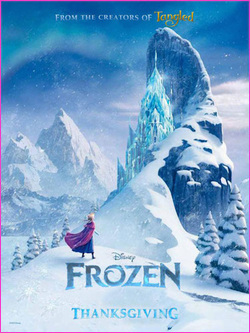
What is so special about Frozen that has enabled it to gross nearly $1.2 billion (yes, with a “b”) worldwide since its release? Could it be funny scenes, like the one where Olaf and Sven battle it out across the throws of a frozen pond to reach Olaf’s discarded nose (which itself is the subject of litigation over copyright infringement)? Threads like this woven throughout the plot make the movie as a whole special and contribute to the entertainment value of the film, but the true essence of the movie is the overarching theme of sisterly love sprinkled with the usual obstacles of overcoming physical and emotional hardships and, of course, realizing true love.
In case you are wondering, I will go out on a limb and say, “yes, you probably have seen this before.” Yet, Tanikumi (the author who claims Disney lifted the storyline of Frozen from a book she wrote) is claiming that her story wasn’t something you have seen before. Here is a table showing some of the elements from Tanikumi’s book, all of which are cited in her suit against Disney for copyright infringement as elements that are similar to elements in Frozen:
1. Village near snowy mountains: Story is set at the base of a snow covered mountains where two sisters live with their parents.
2. Two sisters: Both sisters are a few years apart, have opposite hair colors, and each own a horse.
3. Intense sisterly love: one sister has a deep love for the other sister.
4. Older sister accidentally hurts younger sister: the two sisters are playing when one falls into a vat of hot custard, becoming severely injured.
5. Younger sister falls in love: the suitor-to-be is a dark haired, tall and fair man
6. The suitor-to-be has competition: another man has a love interest in the younger sister (who is conflicted about who she really loves)
Disney had been inspired by at least a few of these elements from at least one classic story: Hans Christian Andersen’s book The Snow Queen. Disney had been trying to make a film based on this fairy tale, which chronicles the struggle between good and evil involving two friends, one of whom is immobilized by a cold spell, since at least the 1940s. While the script went through many rewrites during the course of writing, some of the main concepts inspired by the Snow Queen itself remained with the story, including the element of evil, represented by a “frozen heart”. As one of the film directors stated: “That was a concept and the phrase… an act of true love will thaw a frozen heart.” It was this “frozen heart” hook that the writers really believed would capture the hearts of audiences. So it seems like the Snow Queen motif of good vs. evil, using the vehicle of snow and ice to convey this motif, is the main element of the plot.
Once you distill the theme of the plot down to this base, it seems like other elements follow naturally. Because the elements follow naturally, they are classified as “scenes a faire”, a doctrine in copyright law that relates directly to the copyrightability of a piece. Under the scenes a faire doctrine (French for “scene that must be done”), a particular element is considered as so commonplace that an audience expects that element to be included in a work, either because the element is necessary given the type of plot or the element is an outgrowth of the underlying plot based on other themes in the work. As one court commented “the public domain would have a scant selection if stock settings such as the movie theatre, the kitchen, Las Vegas, a church picnic or a club were subject to copyright protection”. The scenes a faire doctrine is a strain of the idea that ideas cannot be protected as copyrightable subject matter because they are not expressive and do not require any creativity. Expression of these ideas, however, is the true essence of copyright.
This is not to say that a work that includes scenes a faire elements is totally excluded from copyright protection. Instead, it is used as a tool for comparing two different works to see if one copies the other. If a latter work accused of infringing an original work only includes common scenes a fair elements, there is no substantial similarity between the two works and the latter work cannot be infringing. This concept is illustrated wonderfully by the case involving a cookbook written by Jerry Seinfeld for parents with finicky kids. The book was written to specifically address how parents could trick their kids into eating vegetables by hiding veggies in other foods. Another author wrote a book about the same subject and sued Seinfeld for copyright infringement. After looking at both books, the court found the topic of stockpiling vegetable purees covertly into other foods in the hopes that a child will eat it really isn’t something you can copyright. Other similarities between the books including the titles, inclusion of illustrations of prepared dishes, health advice, personal narrative, descriptions of how to make purees, and instructions for preparing dishes were all scenes a faire because they are elements that flow naturally from concepts covered in a cookbook.
Applying that same reason to the case of Frozen, one sees how quickly Tanikumi’s claim of infringement evaporates. First, the elements that she has highlighted as being copied by Frozen seem like nothing more than common themes (sisterly love, a disaster that separates both sisters, a journey of one sister to find the other one, a romance, etc.). Second, even if the elements are not common themes, they are still just ideas and they are only protected to the extent that Frozen copied the expression of these ideas (i.e. arranging each element in such a way that an ordinary observer would think that the two works are similar). Given the whole concept of Frozen, its setting (which appears completely distinct from those in Tanikumi’s book), and its main theme of “love can thaw a cold heart”, it seems that the works are very different.
We’ll have to see how this case shakes out in court and whether Tanikumi’s good (an innocent, small-time author) vs. evil (a big, multimedia conglomerate) theory of the case wins the day in court.


 RSS Feed
RSS Feed